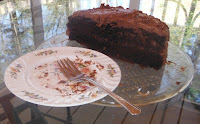(With profound apologies to Laura Numeroff)
 |
| The heucheras caught her attention |
If you go to a flower
show with a gardener, she’s going to suggest that the two of you return to the
show on Sunday afternoon. She’ll also
suggest you fill the car with empty crates.
When you return to the
flower show on Sunday, you’re going to find that she has made a sharp deal with
one of the landscape exhibitors to purchase 125 of the heucheras and tiarellas
that populated an exhibit she admired.
She’s going to ask you to carry the now-plant-filled crates back to the
car.
 |
| Tiarellas come home |
When you get home, she’ll
ask for your help planting the heucheras and tiarellas. But not right away because it's too cold. So you'll move them in and out of the garage every day to give them light but protect them at night against frost. Once they're planted, she’ll also notice that while they make a
nice ground cover, she's going to need accent plants.
She’ll ask you to accompany her to a nursery.
At the nursery, she’ll
remember how much money she saved on those heucheras and tiarellas. She’ll therefore decide that your landscape
could also use some fothergilla, viburnum, itea, kalmia, and other native
plants. She’ll ask your advice on which
ones look best. She’ll also ask your
help in planting them.
 |
| So we needed compost... |
All these new plants and
ground covers will require compost. She
will order ten cubic yards of compost which will be delivered to the front of
your property. She will ask you to move the
eight unused cubic yards of compost to the back of the property. You will require lots of ibuprofen.
When the new native
plants are arrayed around the property, she’ll discover that certain other
shrubs, planted the previous year, no longer look attractive in their original
locations. She will ask you to dig them
up and re-plant them ten feet away.
 |
| Native plants going to a new home |
When the new fothergilla,
viburnum, itea, kalmia, heucheras, and tiarellas are in place, she will be exceptionally
pleased. She will be so pleased that she
will go to a nursery specializing in native perennials and come back with a car
laden with dozens of ferns and wildflowers.
She will ask your help in planting them in special locations. Some of these locations will require digging
through what seems like solid granite.
When the new ferns and
wildflowers are planted you will need a long nap. While you nap, she will bake you a chocolate
cake with raspberry filling. When you
awaken from your nap and enjoy a slice of the cake, chances are you will
remember that the next flower show is just ten months away.















